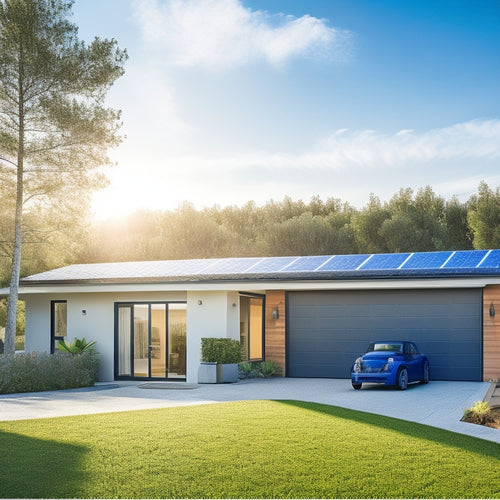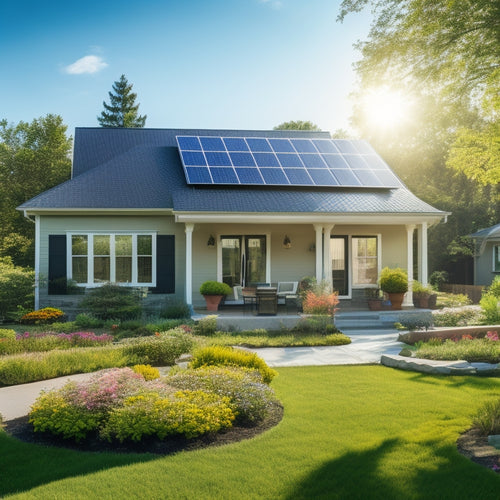
Why Large Buildings Need Solar Energy Solutions
Share
As a large building owner, you're likely aware of the significant energy expenses and environmental impact that come with operating a massive facility. By integrating solar energy solutions, you can diminish your dependence on the grid, lower your energy bills, and reduce your carbon footprint. You'll strengthen grid resilience, guarantee operational continuity, and fortify energy security. Plus, you'll attract environmentally conscious investors, boost your corporate image, and increase property value. From reducing operating expenses to future-proofing with renewable energy, the benefits of solar energy solutions are vast - and exploring these advantages could be the key to unlocking a more sustainable, cost-effective future for your building.
Key Takeaways
• Large buildings can reduce energy bills by up to 50% and minimize exposure to fluctuating energy prices with solar energy solutions.
• Solar power enhances grid resilience, ensuring operational continuity during power outages and reducing the risk of power disruptions.
• On-site energy generation with solar energy solutions reduces dependence on the grid, improves fuel efficiency, and decreases carbon footprint.
• Solar energy solutions provide control over energy costs and usage, allowing for predictable budgeting and reducing supply disruptions.
• By adopting solar energy solutions, large buildings can future-proof themselves by meeting carbon neutrality targets, enhancing energy independence, and boosting property value.
Reducing Energy Dependence on Grid
By integrating solar energy systems into your building's infrastructure, you can greatly reduce your reliance on the grid and lower your energy bills. This not only saves you money but also enhances grid resilience, guaranteeing that your building remains operational even during power outages.
With solar energy, you gain energy autonomy, allowing you to manage your energy usage more effectively. By generating your own clean energy, you can optimize your energy consumption and reduce your dependence on the grid. This, in turn, fortifies your building's energy security and diminishes the risk of power disruptions.
Environmental Benefits of Solar Power
By adopting solar energy, you'll greatly decrease your building's carbon footprint, lessening the impact of greenhouse gas emissions on the environment. This reduction in emissions directly translates to improved air quality, creating a healthier environment for occupants and the surrounding community.
As a building owner, you'll contribute to a cleaner atmosphere, free from pollutants that exacerbate respiratory issues and other health problems. By harnessing solar power, you're reducing your reliance on fossil fuels, which are significant contributors to air pollution.
Lowering Operating Expenses Long Term
Solar-powered buildings typically reduce their energy bills by up to 50%, freeing up resources for more strategic investments. By integrating solar energy into your building's infrastructure, you can markedly decrease your operating expenses. This means you'll have more control over your budget, allowing you to allocate funds to areas that drive growth and improvement.
With solar energy, you can achieve long-term cost savings and optimize your budget. By reducing your reliance on traditional energy sources, you'll minimize your exposure to fluctuating energy prices, ensuring a more stable financial future.
Government Incentives for Solar Adoption
You can make the shift to solar energy more affordable and realize a faster return on investment by taking advantage of various government incentives designed to encourage the adoption of solar energy, which can greatly offset the upfront costs of installation.
These incentives can greatly reduce the financial burden of going solar. For instance, you may be eligible for tax credits, which can provide a substantial reduction in your taxable income. Additionally, grant programs are available to help cover the costs of installation. These programs are designed to promote the use of renewable energy sources and reduce our reliance on fossil fuels.
Enhanced Property Value and Credibility
As you consider integrating solar energy solutions into your large building, you'll likely see an increase in your property's worth. This boost in value is a direct result of the enhanced credibility that comes with adopting sustainable energy practices.
Increased Property Worth
Installing solar energy systems on large buildings can greatly enhance property value, making them more appealing to tenants and investors alike. By incorporating solar energy solutions, you can increase your property valuation, attracting potential buyers or renters who value sustainability and energy efficiency.
This, in turn, opens up new investment opportunities, as environmentally conscious investors seek out properties that align with their values. With a solar-powered building, you can command a premium on rent or sale price, setting your property apart from competitors.
As a property owner, you'll benefit from increased property worth, improved cash flow, and a stronger market position. By investing in solar energy, you're not only reducing your carbon footprint but also boosting your bottom line.
Boosted Corporate Image
By integrating solar energy systems into your large building, your organization can project a forward-thinking, eco-friendly corporate image that resonates with customers, employees, and stakeholders. This enhanced reputation can lead to increased brand loyalty and social responsibility, setting your company apart from competitors. The benefits of a boosted corporate image are multifaceted:
| Benefit | Description | Impact |
|---|---|---|
| Enhanced Credibility | Demonstrated commitment to sustainability | Increased brand loyalty |
| Improved Reputation | Perceived as environmentally responsible | Attract top talent and customers |
| Increased Customer Trust | Association with eco-friendly practices | Long-term customer relationships |
| Competitive Advantage | Differentiation from competitors | Market leadership |
| Improved Employee Morale | Alignment with personal values | Increased productivity |
Meeting Energy Demands Sustainably
You can greatly decrease your reliance on fossil fuels and lower your carbon footprint by integrating solar energy systems into your large building's infrastructure. This shift towards renewable energy enables you to meet your energy demands sustainably.
By incorporating energy storage solutions, you can guarantee a stable and reliable energy supply, even during periods of high demand or grid instability. This, in turn, enhances grid resilience, reducing the likelihood of power outages and brownouts.
Energy Independence for Large Sites
As you consider energy independence for your large site, you're likely looking for ways to reduce your reliance on the grid and minimize your energy expenditures.
By leveraging renewable energy sources, such as solar power, you can generate electricity on-site and decrease your dependence on external energy suppliers.
This approach enables you to take control of your energy needs and create a more sustainable, self-sufficient energy infrastructure.
Renewable Energy Sources
Large sites can substantially decrease their reliance on non-renewable energy sources by incorporating a mix of renewable energy sources, including solar, wind, and geothermal power, into their energy portfolios.
You can take control of your energy independence by investing in green technology, which not only reduces your carbon footprint but also saves you money in the long run.
By diversifying your energy sources, you'll be less dependent on the grid and better equipped to manage your energy costs.
Additionally, energy storage solutions can help you store excess energy generated by your renewable sources, ensuring a stable and reliable power supply.
On-Site Power Generation
By integrating on-site power generation systems, such as solar panels or wind turbines, into their infrastructure, sites can greatly reduce their reliance on external energy sources and take an essential step towards energy independence. This approach enables you to produce energy locally, reducing your dependence on the grid and minimizing the risks associated with grid outages.
On-site power generation also contributes to energy decentralization, promoting grid resilience and reducing the strain on the central grid.
Here are just a few benefits you can expect from on-site power generation:
-
Improved energy security: Reduce your reliance on external energy sources and guarantee a steady supply of power.
-
Enhanced grid resilience: By generating power on-site, you're reducing the strain on the central grid and promoting a more resilient energy infrastructure.
-
Increased energy autonomy: Take control of your energy needs and lessen your dependence on external providers.
- Reduced energy costs: Generate your own energy and decrease your energy expenditure.
Reduced Reliance
You can achieve energy independence for your large site by reducing your reliance on external energy sources, allowing you to better manage your energy needs and mitigate the risks associated with grid outages.
By generating your own energy on-site, you'll reduce your dependence on the grid and enhance your energy security. This, in turn, will improve your fuel efficiency and reduce your carbon footprint.
With solar energy solutions, you'll have more control over your energy costs and usage, ensuring a more predictable budget. Plus, you'll be less vulnerable to price fluctuations and supply disruptions.
Future-Proofing With Renewable Energy
As the world shifts towards a low-carbon economy, building owners and facility managers must prioritize future-proofing their properties with renewable energy solutions to minimize their carbon footprint and stay competitive. You can't afford to lag behind in this evolution. By investing in solar energy solutions, you'll not only reduce your reliance on fossil fuels but also secure a sustainable future for your building.
Here are some compelling reasons to future-proof with renewable energy:
-
Meet carbon neutrality targets: Stay ahead of regulations and achieve your sustainability goals.
-
Reduce energy costs: Lower your energy expenses with on-site renewable energy generation.
-
Enhance energy independence: Rely less on the grid with energy storage systems.
- Boost property value: Increase your property's value with a forward-thinking approach to sustainability.
Frequently Asked Questions
What Is the Average ROI for Solar Panels on Large Commercial Buildings?
You can expect an average ROI of 10-15% for solar panels on large commercial buildings, driven by financial incentives, energy savings, and cost benefits, plus government grants, which support green initiatives and reduce environmental impact.
Can Solar Energy Systems Be Installed on Rooftops With Skylights or Vents?
You can install solar energy systems on rooftops with skylights or vents, but you'll need to navigate rooftop obstacles and ventilation challenges, ensuring a secure, watertight seal around these features to maintain system efficiency.
Are There Any Specific Solar Panel Brands Recommended for Large Buildings?
As you navigate the solar panel market, think of it as charting a course through a starry night sky, where each brand is a guiding light; for large buildings, look for brands meeting industry standards, with Trina, Hanwha, and Jinko standing out in brand comparison.
How Do Solar Panels Perform During Periods of Low Sunlight or Snow?
You'll find that solar panels' energy efficiency decreases during low sunlight periods, but advanced panels with high-efficiency cells can still generate some power; during winter, snow can reduce performance, but tilted panels and snow-clearing systems can mitigate this impact.
Can Existing Buildings Be Retrofitted With Solar Energy Systems Easily?
You'll face retrofitting challenges, but with energy audits, compliance with building codes, and thorough structural assessments, you can overcome installation difficulties and successfully integrate solar energy systems into your existing building.
Related Posts
-

Solar Energy Storage Options for Homes
When considering solar energy storage options for your home, you'll find several effective solutions. Battery systems...
-

Energy-Efficient Home Upgrades for Cost Reduction
To reduce costs with energy-efficient home upgrades, focus on essential improvements like smart thermostats, energy-e...
-

Affordable Solar Panels for Home Use
Affordable solar panels offer you a smart way to cut down on energy costs while promoting sustainability. With govern...


